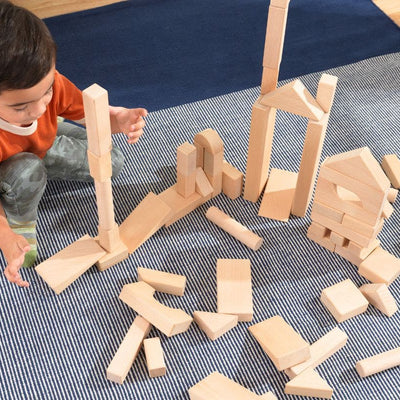The Connection Between Playtime and Attention Span in Children

Our kids’ attention spans can be a real mystery at times. One minute, we’re super impressed by their laser-like focus on that Lego tower they’re building. And the next, we swear they have the attention span of a goldfish as they literally forget to put pants on. In this post, we’ll try to clear up at least a little bit of that mystery and explore how we can help our children grow in focus and attention through their favorite thing: play!
Understanding Attention Span in Children
Attention span refers to the ability to concentrate and sustain focus on a task or activity. According to the American Academy of Pediatrics, “a normal attention span is 3 to 5 minutes per a child's year of age.” In other words, a two-year-old can usually focus on a task for 6-10 minutes at a time; a three-year-old for 9-15 minutes, and so on.
But it’s important to remember that these ranges are only estimates, and your child’s attention is influenced by a variety of factors, including hunger, tiredness, how much physical activity they’ve had, their own interest in the task at hand, and the environment around them. Rather than a set-in-stone time frame, it’s more helpful to think of your child’s attention span as a flexible range that can vary depending on the current circumstances.
You’ve likely seen this firsthand! When your little one is well-rested, has a full tummy, and has had plenty of time running around outside, they can give impressive focus to an engaging task like doing a puzzle or building a block tower. But when they’re sleepy, hungry, and have been cooped up on a rainy day? They may have very little ability to focus on that very same task.
In general, your child’s attention span will increase on its own over time, but that doesn’t mean we can’t help our children grow in this area. By being intentional about our home environment, our kids’ schedules, and plenty of playtime, we can help set them up for success!
The Role of Playtime in Child Development
Scientists are still exploring exactly how play develops kids’ attention. We do know that play is critical for all aspects of a child's development, including physical, social, emotional, and cognitive growth. It fosters creativity, imagination, problem-solving skills, and communication abilities. And as these abilities grow, so do kids’ attention spans.
Play allows children to experiment, explore, and make sense of the world around them. They learn to regulate their emotions, interact with peers and adults, solve problems, create new things, and discover their own individual interests. For a deeper dive into all the ways play drives development, check out our Child Development series.
Research Studies on the Connection Between Playtime and Attention Span
So what does the science have to say about play and attention? Unsurprisingly, research backs up what parents and teachers observe on their own every day: opportunities for play improve kids’ attention span on other tasks later. Physical play, in particular, seems to boost kids’ ability to focus. This 2021 study found that kids who got more physical activity had better self-regulation and more “cognitive readiness” for preschool, both of which are critical factors for attention and focus. And many studies have found that kids have better classroom behavior and more attention for academic tasks after recess or “brain breaks” that include physical play.
It’s also well-documented now that excessive screen time negatively impacts children’s attention spans. Engaging kids in play rather than screen-centered activities is a great way to protect them from the negative effects of screen time.
Strategies to Enhance Attention Span Through Playtime: Practical Tips for Parents and Caregivers
So, how can parents and caregivers use that research in their day-to-day life? These practical tips will help you create an environment and routine that prioritizes play and supports kids’ focus and attention span!
- Get moving!
- Research confirms what we know intuitively: kids are made to move! Getting plenty of physical activity and movement helps enhance kids’ attention span for less-active tasks later. Integrate active play into your daily routine, preferably outdoors whenever possible. Our
- and
- can help!
- Limit screen time
- Along with physical activity, limiting screen time may be the most important thing we can do for our kids’ attention spans. We love the American Academy of Pediatrics’
- . It helps you identify your goals and craft a media plan that works for your family!
- Encourage open-ended play
- We know that physical play is critical, but other types of play help kids develop focus and attention too! Provide children with toys and imaginative and creative play. Open-ended play allows children to engage in self-directed activities, encouraging them to focus, problem-solve, and sustain attention.
- Play games that require focus
- Engage children in games that require concentration, memory, and attention to detail. Examples include memory games, puzzles, and board games that involve strategy and problem-solving.
- Create a play-friendly environment
- and other distractions can help kids focus on their play for longer periods of time. By simplifying and providing a few quality toys, you can help your kiddo focus on one activity at a time.
- Prioritize playtime
- It sounds simple, but between errands, scheduled activities, preschool, and more, it can be tough to make play a priority. Be mindful of how much time your child spends in structured activities (like school, organized sports, clubs, etc.) and set aside dedicated time for unstructured play, both indoors and outdoors.
Final thoughts
Will increasing playtime suddenly increase your child’s attention span by hours? Nope. Will it support their overall development and gradually improve their attention span over time? Absolutely. By making sure our kids get adequate unstructured playtime, especially active play outdoors, we give them the breaks they need to regulate, reset, and give focused attention to other tasks later. We can also help them out by minimizing screen time and fostering other types of play instead.
Create an engaging play environment at your house with our selection of open-ended toys. Use our Shop by Skill page to find toys geared towards active and outdoor play, cognitive play, imaginative play, and more!














